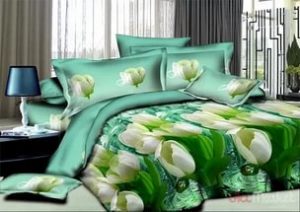 Satin – a more natural fabric (than polysatin), made from cotton threads.
Satin – a more natural fabric (than polysatin), made from cotton threads.
The material is highly soft, pleasant to the body, and holds heat well. The body under such bedding breathes well on a hot night, and on winter evenings the linen keeps you warm. The fabric is highly durable due to the special weave of the threads. When washed, satin does not fade or deform. This material will not shrink and will last a long time. Service life may last up to 8 years.
 IN polysatin composition added synthetic threads. It can be uniform using polyester. This fabric is used for sewing materials for furniture upholstery, curtains or work clothes. Polysatin can be mixed; it uses cotton threads with the addition of polyester. It is better suited for home clothes (shirts, robes). It is often used for sewing sheets, duvet covers and pillowcases. Its manufacturing technology is similar to satin in that there are “weft” threads on the front side.
IN polysatin composition added synthetic threads. It can be uniform using polyester. This fabric is used for sewing materials for furniture upholstery, curtains or work clothes. Polysatin can be mixed; it uses cotton threads with the addition of polyester. It is better suited for home clothes (shirts, robes). It is often used for sewing sheets, duvet covers and pillowcases. Its manufacturing technology is similar to satin in that there are “weft” threads on the front side.
Satin characteristics, composition
 Satin is made from cotton threads without synthetic impurities.
Satin is made from cotton threads without synthetic impurities.
Pros:
- Virtually no ironing required
- Maintains a presentable appearance for a long time
- Bed linen will not slide on the mattress, because the reverse side is without shine and terry
- Suitable for use at any time of the year.
Flaws:
- The price of high-quality satin is quite high
What is sewn from satin
You can sew a variety of things from this fabric: clothes for adults and children, bed linen.
Polysatin characteristics, composition
 It can be made entirely of polyester, but a mixed version is often used, supplemented with cotton threads.
It can be made entirely of polyester, but a mixed version is often used, supplemented with cotton threads.
Pros:
- Durability and increased wear resistance
- Doesn't fade in the sun
- Withstands multiple wash cycles
- Doesn't tear
- Wash well when dirty
- It does not need to be ironed (practically does not wrinkle)
- Dries quickly after washing
- Easy to process.
- More affordable price
Flaws:
- Not suitable for tailoring due to airtightness
- Causes allergies
Kinds
Industrial. Composition: 100% polyester.
Domestic. Composition: cotton and synthetics in different proportions. Threads can be used in proportions 50 to 50 or 35 to 65%.
What is sewn from polysatin
From the industrial type of material you can sew bags, rugs, rugs, awnings, and work clothes. Some manufacturers make bed linen sets with fashionable 3D printing from them. Because the fabric has a beautiful shine, and the image on it is bright.
Expert opinion on what is better: satin or polysatin
 If you compare two materials, then it is worth deciding what is the important criterion for purchasing (cost, naturalness of the composition, properties of the material).
If you compare two materials, then it is worth deciding what is the important criterion for purchasing (cost, naturalness of the composition, properties of the material).
Polysatin is a cheaper material, but it’s still not worth purchasing children’s clothes or clothes for allergy sufferers from it. If you want to buy beautiful, stylish bed linen with photo printing, you can buy a polysatin set, but do not use it all the time.
Satin is a more expensive material with a beautiful shine. The material will last a long time, the body breathes under it. It wicks away moisture well and is breathable. Consumers love it for its natural composition.
The purpose of the thing you plan to buy is important. For example, if it is a stylish bag, curtains for the living room or an awning from sunlight, then you can save money by buying something made of polysatin.
 If you plan to buy a robe or pajamas for home, you can purchase something made from polysatin blend or satin. This fabric will be more pleasant to the body.
If you plan to buy a robe or pajamas for home, you can purchase something made from polysatin blend or satin. This fabric will be more pleasant to the body.
It is better to purchase dresses from satin. This material has a noble shine, it is very beautiful and practically does not wrinkle. A dress made of this material can be worn for a long time, it will not deform or stretch.
If you have a choice between two fabrics and need to buy bed linen, then it is better to choose satin. Such kits have a natural composition. Its cost is more expensive, but the person sleeping under it will not sweat and the set will be pleasant to the body. And underwear made from polysatin will slip and is less breathable.


 2
2





